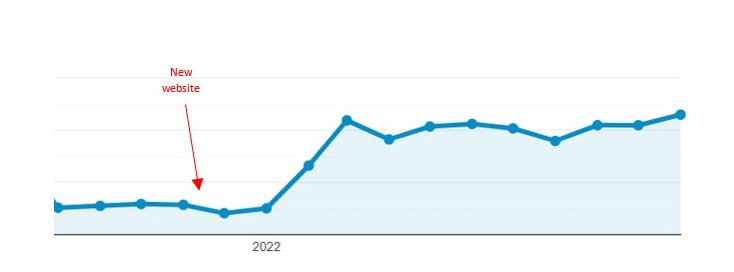Designing for people also means working to make the site visible and accessible to those seeking information on search engines
The beauty of the projects we follow at TSW also lies in the peculiarities of each case, often linked to the specific needs and collaboration with other suppliers of our clients. If we think, for example, about putting a site online, each project can include all the phases, from designing the company’s coordinated image to ongoing consultancy for visibility and content production. For Cetif, for example, we took care of the entire design of the platform.
But there are also cases in which we are contacted after a project has already started, for vertical and specialist support in a single area of design, such as that of organic visibility on search engines. They therefore ask us for SEO consultancy to understand how to act. As we have already said in another article, for us SEO is much more than search engine optimization. For us, SEO is hospitality, because we want to help our clients welcome people to their sites, as if they were inviting them into their home. For us, SEO is about creating the best online browsing experience possible.

This is the case of Italmatch Chemicals, a world leading group in the chemical sector, specialized in water treatments, lubricants, fuels, plastics and personal care products. This company contacted us to help them in a crucial phase of putting a new site online, an activity that is often underestimated: SEO migration.
To talk to you about this fundamental activity, let’s start from the beginning of our collaboration.
Italmatch Chemicals and SEO migration: how to improve organic visibility.
In 2021 Italmatch Chemicals, in view of the restyling of their websites, wanted us to support the development agency to follow and correctly manage the migration, with the aim of preserving and improving the organic visibility of the group’s sites.
The involvement of an SEO agency in the event of a site redesign is a fundamental step to validate each phase: from the analysis of the tree, to the definition of the templates and the mapping of all the pages to be migrated. To use a metaphor, “migrating” a site is like “moving”, it therefore becomes necessary to update users, engines and sites that link to us by communicating the new addresses for the resources contained therein.
Many pages, in fact, are present and visible in Google search results and linked to pages of other sites, or present in users’ bookmarks. An incorrect migration can therefore lead to an unreachable address and an error or 404 page.
The consequence is a slow but inexorable disappearance from search engine indexes, a negative user browsing experience and an obvious decline in a good part of the visibility acquired over years of work.
To better understand this activity and how we manage it, let’s delve deeper into the concept of SEO migration.
SEO migration: what it is and why it is important
The SEO migration activity is fundamental in the case of moving from an old site to a new one, to safeguard the value in the eyes of Google of what has been achieved up to that point. We can talk about Google, meaning search engines in general, given that it covers 90% of global market shares, while in Italy and France it reaches over 98%.
We were saying: a site acquires a certain visibility on search engines over time. The more its contents respond to people’s searches, and therefore to Google’s algorithm, the more they will rightfully enter the SERP and, the most optimized, the first page, also giving companies business opportunities.
In other words: a site with a longer history, which has responded to people’s searches over time and has positioned itself for certain queries, has more value for search engines than a site that has just been put online from scratch. So how can you preserve this value when you decide to change site? With an SEO migration.
To position any page of a site – for better or worse – among the search results, Google needs to store and catalog the addresses of these pages: the so-called URLs. Moving to a new site often brings with it a substantial series of changes to what Google already knows about what populates that domain. In particular, in this phase a review of the information architecture and the use of a different name for the page URLs are often implemented. This leads to “emptying” of the old URLs of the resources contained in an “old” page, which are often “moved” to a different address. These changes happen for various reasons:
- Needs related to the new structure designed for the new site
- Necessities and technical limitations related to a new platform or CMS used
- Little attention to the layout of the contents or the name of the URLs used, when carrying out data entry to populate the new site.
But what if we changed the addresses to our web pages without “notifying” Google? To return to the metaphor: it would be a bit like moving without notifying anyone of our new address. We would no longer be traceable (visible).
Obtaining good visibility on search engines often costs effort, time and investments. Migration to a new site is precisely the riskiest moment to lose all the visibility acquired on Google, often creating serious economic damage to the company. This is why we try to intervene with the SEO migration during the “web” migration: to save all the consolidated work up to that point.
How to improve the SEO efficiency of the italmatch.com website
With Italmatch Chemicals we decided to prepare an SEO migration divided into three phases:
- The first involved an analysis of the many domains owned by the client (domain strategy)
- The second was the SEO tech and content optimization of the site templates and pages
- The last one concerned the mapping of URLs and the implementation of redirect rules for all the most relevant pages
Domain management
Over the years, the client has acquired several dozen web domains, as a consequence of its acquisition strategy of other companies or following brand protection activities on many Italmatch Chemicals products. We then analyzed the domains one at a time and evaluated their behavior:
- Some of these were not reachable for various reasons
- Others responded with incorrect redirects
From this analysis, and the related mapping of the state of the art, a plan was decided in agreement with the client and its IT department, to rationalize their domain assets, optimally conveying the historical value of the old pages, towards the new.
SEO optimization WordPress platform
Once the first phase was completed, we dedicated ourselves to the SEO optimization of the platform, in this case on WordPress CMS. We therefore have:
- Revised the URL structure and optimized the information architecture
- Optimized the html code and headings tag structure
- Created individual product pages so they could be indexed by Google
- Inserted short SEO driven texts for category pages without text.
In addition, we have inserted “contact us” CTAs on various pages of the site to obtain more contacts, an activity more linked to usability and the conversion objective.
301 redirect for SEO migration
The last phase was the most delicate and began by mapping all the pages that received a high number of visits and backlinks, those with the most important historical value that absolutely needed to be preserved and therefore migrated page to page.
Following this analysis, the rules for the redirects of these URLs towards the new pages that are more consistent in terms of content were prepared and were correctly inserted into the .htaccess file of the sites by the Italmatch IT team.
The results
After an initial re-evaluation by search engines, the new Italmatch Chemicals sites have seen a significant improvement in their visibility.
In the space of a few weeks we have witnessed an increase in both SEO positioning and traffic received from the sites involved in our activities.
In addition, we noticed how the new product pages were almost all positioned in first position for the name of the products and how the number of contacts basically tripled.

In the graph, the trend of traffic to Italmatch.com from September 2021 to November 2022
This demonstrates how the value of a site’s contents for people, past or present, continues to be a fundamental ranking factor for Google and how working on the SEO side fully reflects our approach to listening and welcoming on the web.